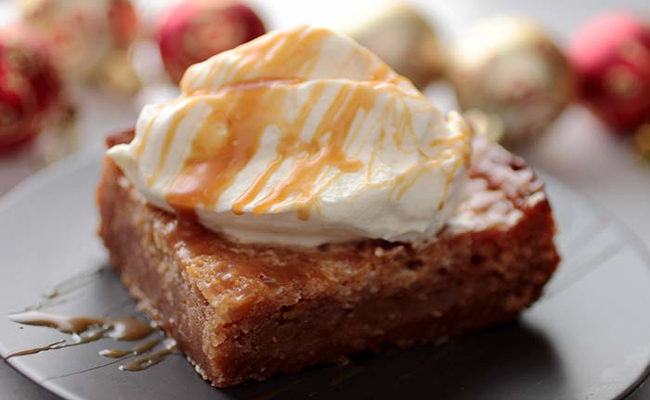Persimmon Pudding: A Classic American Dessert with Deep Roots
Discover the Rich History and Delightful Flavors of Persimmon Pudding

Featured Snippet: Persimmon pudding is a beloved American dessert made from the pulp of ripe persimmons, mixed with ingredients like flour, sugar, eggs, and spices. This dish, rooted in the Midwest, particularly Indiana, offers a blend of sweet, custard-like texture with warm, autumnal flavors. Traditionally served with ice cream or whipped cream, persimmon pudding is a seasonal favorite that highlights the unique flavor of native American persimmons, making it a must-have for fall and holiday tables.
Introduction to Persimmon Pudding
Persimmon pudding is more than just a dessert—it’s a slice of American history. With its origins deeply rooted in Midwestern and Southern culinary traditions, this dish encapsulates the rich, sweet, and slightly tangy flavor of the persimmon fruit. The American persimmon, a native fruit found in abundance across the Midwest, particularly Indiana, has been used in recipes for generations. The dessert itself is versatile, with recipes ranging from cake-like consistency to a softer, pudding-like texture. In this article, we’ll explore the history, preparation methods, variations, and cultural significance of persimmon pudding, while also offering tips on how to make the best version of this timeless dish.
The History of Persimmon Pudding
The use of persimmons in American cooking dates back to indigenous cultures and early settlers, who relied on the fruit for sustenance. Persimmons grow abundantly across the Midwest and Southern U.S., especially in states like Indiana and Kentucky. Native Americans were the first to recognize the value of this unique fruit, incorporating it into their diets by drying it, making breads, or even brewing beverages.
As European settlers arrived, they adopted these traditions, adding their own ingredients like sugar, milk, and flour, which eventually led to the creation of the persimmon pudding we know today. By the 19th century, persimmon pudding had become a staple in many households across the Midwest, prized for its rich flavor and the ease of preparing it during the fall harvest season.
What is Persimmon Pudding?
At its core, persimmon pudding is a baked dessert made from ripe persimmon pulp, eggs, sugar, and flour. The addition of spices like cinnamon, nutmeg, and cloves gives the pudding its distinctive autumnal flavor. Some recipes call for a custard-like consistency, while others are more cake-like in texture. Traditionally, it’s served warm with accompaniments like whipped cream, caramel sauce, or vanilla ice cream.
The key to a successful persimmon pudding is the quality of the persimmons themselves. Only fully ripe persimmons, which have a rich, jelly-like consistency, should be used, as unripe persimmons are highly astringent and can ruin the dish.
Ingredients and Preparation
To make the perfect persimmon pudding, you’ll need a few basic ingredients, but the persimmons must be the star of the show. Here’s a typical list of what you’ll need:
- 2 cups of ripe persimmon pulp
- 2 cups of sugar
- 3 eggs
- 1 ½ cups of flour
- 1 ½ teaspoons of baking soda
- 1 teaspoon of cinnamon
- 1 teaspoon of nutmeg
- 1 cup of milk
- ½ cup of melted butter
Step-by-Step Process:
Prepare the Persimmons: First, ensure your persimmons are fully ripe. They should be soft to the touch, and their insides should have a jelly-like texture. Remove the skins and seeds to extract the pulp.
Mix the Ingredients: In a large bowl, mix together the persimmon pulp, sugar, eggs, and melted butter. In a separate bowl, sift together the flour, baking soda, cinnamon, and nutmeg. Gradually add the dry ingredients to the persimmon mixture, alternating with the milk until the batter is smooth.
Bake: Pour the batter into a greased baking dish and bake at 325°F (163°C) for 60-75 minutes, or until the center is set and a toothpick inserted comes out clean.
Serve: Once baked, allow the pudding to cool slightly before serving. It pairs wonderfully with whipped cream or a scoop of ice cream.
Variations of Persimmon Pudding
While the classic recipe is beloved by many, there are several regional and modern variations of persimmon pudding that offer different textures and flavors:
- Steamed Persimmon Pudding: This method gives the dessert a moist, dense texture, more akin to traditional British puddings.
- Gluten-Free Version: Substitute regular flour with almond flour or a gluten-free flour blend for those with dietary restrictions.
- Spiced Rum Persimmon Pudding: Adding a splash of rum or bourbon to the batter enhances the depth of flavor, providing a richer, spicier taste that complements the natural sweetness of the persimmons.
The Cultural Significance of Persimmon Pudding
In Indiana, persimmon pudding holds a special place in the hearts of locals. Each year, the town of Mitchell, Indiana, hosts the annual Persimmon Festival, where the dessert is a highlight. The festival celebrates not only the persimmon fruit but also the traditions that have sprung up around it. The event features competitions for the best persimmon pudding, and recipes are passed down through generations, becoming family treasures.
Persimmon pudding is also a nostalgic dish for many, often evoking memories of family gatherings during the fall and winter holidays. Its place on the Thanksgiving table is almost a given in many Midwestern homes, alongside other iconic American desserts like pumpkin pie and apple crisp.
Tips for Making the Best Persimmon Pudding
Use Fully Ripe Persimmons: Unripe persimmons are extremely astringent and can result in a bitter dish. Only use persimmons that are soft and jelly-like in texture.
Don’t Overbake: Persimmon pudding should have a moist, almost custard-like interior. Overbaking can dry out the dessert, so keep a close eye on the oven.
Serve Warm: Persimmon pudding is best served slightly warm, either on its own or with a topping of whipped cream or ice cream. This enhances the richness of the flavors.
Nutritional Benefits of Persimmons
Persimmons, especially the American variety used in persimmon pudding, are not only delicious but also packed with nutrients. They are rich in vitamins A and C, both of which are essential for immune function and skin health. Persimmons also contain dietary fiber, which aids in digestion, and antioxidants that can help protect the body from oxidative stress. By using natural sweeteners like honey or maple syrup instead of sugar, you can make a healthier version of persimmon pudding that still retains all of its delightful flavor.
Conclusion
Persimmon pudding is more than just a dessert—it’s a reflection of American culinary heritage, especially in the Midwest. With its warm, spiced flavors and rich texture, it’s the perfect dish to enjoy during the fall and winter months. Whether you stick to the classic recipe or try a modern variation, persimmon pudding is sure to become a favorite at your table. As the holiday season approaches, there’s no better time to embrace this timeless dessert and share it with family and friends.



